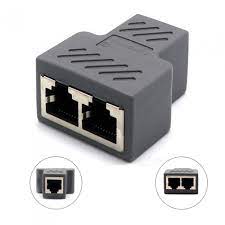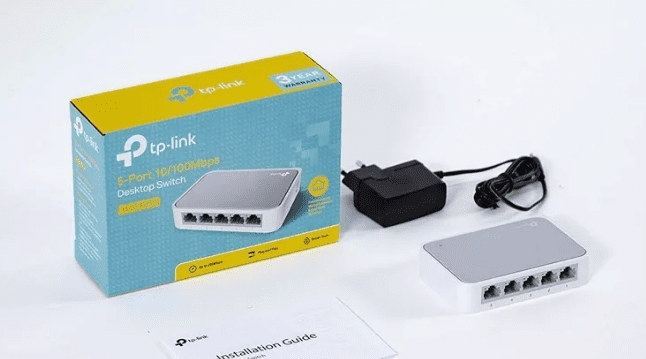An ethernet splitter is basically a network device that splits one ethernet cable into two to connect to two computers in one room and a router in another room. This eases workload since it will be unnecessary to run two ethernet cables from one room to another. Generally, an ethernet splitter allows the sharing of a single ethernet signal across two devices.
What is an ethernet splitter?
These devices are commonly used in pairs, one at the outlet and the other at the patch panel. This, in turn, allows flexibility in network wiring outlines hence allowing more devices to be added. To add on, splitters are one of the most accessible network connection equipment, which does not require power to fire it up.

ethernet splitter
An ethernet splitter does not have special buttons. This is an adorable reason that makes it easy to use. The small device is straightforward as it only consists of three Ethernet ports, one on one side and two on the other end.
These incredible devices have been in use for a long time now, but many still cannot configure them as required. Differing from what many people think, splitters should be purchased in pairs. This has some great reasons and importance that we will look at later in the article.
Looking at this instance of you making a direct connection from one end of the splitter to the router and then connecting two of your devices to the two ethernet ports on one side does not add up. However, we will not leave you hanging on how to configure your devices and the ethernet splitters. Keenly follow the steps below for a perfectly working connection.
How to set up the ethernet splitters
Since splitters help save cables that could be used in setting up a wired connection of your devices in a separate room from the primary signal, we will show you the steps to get it well done. Besides saving cables, it also saves network wall outlets, supplying a reliable connection in most cases. About the point of the splitter coming in pairs that we discussed earlier, let us break it down by using one splitter to merge two signals from a device that will be the router in this case. After that, the other splitter will be used to unmerge the two signals into two paths, allowing the two devices to be connected. Look at the explained sample below for more understanding.
Ethernet splitters
If you have a router in one room, let’s say X and two of your devices in a room, let’s say Y, and in this situation, you have one ethernet wall jack in every room. In such a scenario, you will take one of the splitters, connect two cables to the router, and then connect the other end of the cables to the splitter, thereafter, connect one end of the splitter to the wall jack in room X.
This is where the two signals from the router are merged into one. After that, take the other splitter and connect the one-sided port to room Y’s wall jack. Here, the merged signal of room X will now be unmerged back into two, and now you finally have two ethernet ports for the two devices in room Y.
To simplify this more, one splitter is used to unsplit two signals, and the other one is used to split them. The sample above is one of the simple circumstances that illustrate the importance of having two splitters.
Diving deeper into the splitter topic, let us examine if these devices reduce speed when we use them.
Do Ethernet Splitters Reduce Speed?
Since the randomly asked question is, “does this device slow down the connection?” The answer entirely relies on the type of network where these devices are meant to work from. Generally, the Ethernet splitters are based on the old 100BASE-T standard or the popularly known as Fast Ethernet, which conveys the 100Mbps nominal traffic rate.
For instance, the Cat5e ethernet cable supports 4 pairs of wires. This means that a sum of 8 wires is in one cable. In a Fast Ethernet, there are only two pairs out of the four that are utilized. The other pair remain unused. Here, the splitter will take the two 100Mbps signals from the router, which means two ethernet cables, and merge them on one end.
These signals will then be unmerged into two 100Mbps signals on the other hand. On the receiving end, each port can therefore support or carry a max speed of 100Mbps. Let us now refer to and answer the question. If the instance of a 100Mbps network is used, then the answer is no, the device will not affect the working of your internet speed at all.
However, if your router uses 1Gbps or any network speed above 100Mbps, you split them using an Ethernet splitter to connect to your devices. The rate will be highly reduced to 100Mbps, theoretically. Here you can see that the splitter reduced the speed drastically hence slowing the connection.
Now that we have gone through the splitter’s connections/setup, let us now move to the advantages and disadvantages of this device.
Pros and Cons of Splitters
Ethernet splitters are of really great importance, but they too have drawbacks.
Disadvantages of Splitters
Here, we are going to analyze some of the flaws of this connected device. Some of the weaknesses include speed limitations. An ethernet splitter can only provide up to a maximum of 100Mbps per ethernet port. This means that if you are connected to a network that provides more than 100Mbps, this device’s resources won’t be necessary due to its limitations.
The second weakness is the device support limitation. The splitter is limited to only support a maximum of two devices at a time, so if you have more than two devices to connect, this connection device won’t be the best shot for you whatsoever.
Another impossibility of this device is in a situation where you have one remaining ethernet port in your router. In such a scenario, it is impossible to use the splitters, which means that some sacrifices need to be made.
About reducing the number of cables we looked at earlier in the article, there is still a disadvantage linked with this impression. The drawback is that despite the device reducing the number of cables to connect to, we must have two splitters for the setup to work.
Furthermore, the ethernet cable splitters are not that perfect. In fact, they can cause slower speeds for network traffic. This is not professional as the slower speed will highly affect the performance of your Ethernet-connected devices, which no one would ever want.
Ethernet splitters have been around for years, but simple as they are, there isn’t much improvement to overcome their limitations. The devices are still based on the aging Fast Ethernet standard that may no longer be effective in today’s demand for faster speed. Though these splitters have their advantages, they won’t be worthwhile in most cases.
Advantages of Splitters
On the other hand, the ethernet splitters offer a few advantages. First, we will consider the price; this splitter’s cost is way cheaper than other networking-related equipment. This makes it affordable for anyone to have this device set up without much struggle.
Unlike most networking devices requiring configuration, splitters require neither a software installation nor any configuration to have it up and running. This means that the device is manually set up without any complications.
Another advantage linked with this device is that they are an ideal option for a home setup. This means that splitters work well in a home since the number of devices to be connected are few, typically a maximum of two devices in one room.
Moreover, if you have a connection of 100Mbps network speed and you only have two devices to connect, then splitters will work best for you. This is because the two devices will all receive 100Mbps without a downgrade of the Internet speed.
Some of the best ethernet splitters that we will recommend for you to try include; TP-Link 5 port which is a fascinating one worth trying. This is because the device primarily splits your connections into multiple connections. With this device, you can have up to 4 different connections (1 input port + 4 output ports).

TP-Link 5 port splitter
However, other upgraded versions even support up to 8 output ports. You can also try the Tenda 5-port Gigabit Ethernet Desktop switch. Another great shot includes MT-VIKI 2 ports network switch splitter.
With the growth rate of technology advances, we hope that the ethernet will soon be boosted to support a Gigabit Ethernet standard, but as it stands, it limits people’s work rate in many areas.
Conclusion
Up to this point, we have seen the general meaning of an ethernet splitter as a device that has one port on one side and two output ports on the other end. The device works well in situations where the user has only two devices. However, there are newer versions with four and eight output ports.
Additionally, when purchasing this kind of device, you should make sure you are buying a pair since one will be used to merge the connection, and on the other end, the other device will be used to unmerge the connection.
We also have gone through the advantage of this device on users who have a 100Mbps connection. Users with this kind of connection have nothing to worry about since the device does not slow their connection in any way. However, the slow connection issue arises to users who use a boosted internet connection beyond 100Mbps. Their connection will be stepped down to 100Mbps, which at this point is terrible.
Have you tried the ethernet splitter? Please share with us in the comment section below to see how you are faring with this device. However, at this point, we are sure that you can gauge whether to use or not use this device. Anyways, thank you for reading this article.


2 comments
Hi there,
My modem / router is in my home office. I have a very long ethernet cable that goes from my office to my living room. It is connected to my game console. I recently purchased an Apple TV and I’d prefer to use it wired rather than wifi. Both devices will never be used at the same time, since they are both plugged to the same TV.
Now, if I understand you correctly, I need to buy a pair of splitters; two short cables come out of the router to the splitter which then connect to my long ethernet cable. At the other end, the other splitter redivide in two, each shorter cables going in each devices. Is that correct?
This article seems to be conflating Ethernet splitters and switches (despite the caption, the box for the 5-port tp-link device pictured is clearly labeled as being an ‘Ethernet Switch’ rather than an ‘Ethernet Splitter’). Considering a 5-port un-managed gigabit Ethernet switch can be purchased for less than $20 and only requires a single port on the upstream side, I’m not seeing anything but fairly arcane use-cases for an Ethernet ‘splitter’ (e.g. physical link isolation or very limited client-side power availability).